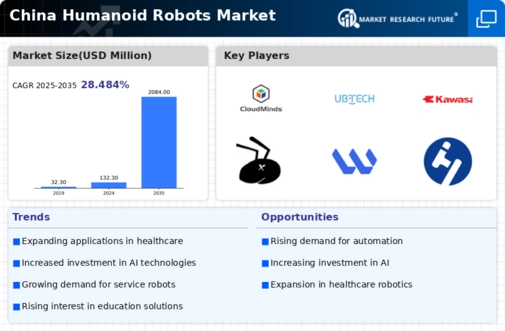The humanoid robots market in China is characterized by a rapidly evolving competitive landscape, driven by technological advancements and increasing demand across various sectors, including healthcare, education, and entertainment. Key players such as UBTECH Robotics (CN), Siasun Robot & Automation (CN), and Hikvision (CN) are at the forefront, each adopting distinct strategies to enhance their market positioning. UBTECH Robotics (CN) focuses on innovation, particularly in AI and machine learning, to develop more interactive and capable humanoid robots. Siasun Robot & Automation (CN) emphasizes regional expansion and partnerships, aiming to integrate its robotics solutions into smart manufacturing processes. Meanwhile, Hikvision (CN) leverages its expertise in surveillance technology to enhance the security features of its humanoid robots, thereby broadening their application scope. Collectively, these strategies contribute to a competitive environment that is increasingly defined by technological sophistication and application versatility.
In terms of business tactics, companies are localizing manufacturing to reduce costs and enhance supply chain efficiency. This approach is particularly evident in the moderately fragmented market structure, where multiple players vie for market share. The collective influence of these key players fosters a dynamic environment, encouraging innovation and collaboration while also intensifying competition.
In November 2025, UBTECH Robotics (CN) announced a strategic partnership with a leading AI research institute to co-develop next-generation humanoid robots. This collaboration is poised to enhance UBTECH's capabilities in AI-driven interactions, potentially setting new benchmarks in user experience and functionality. The strategic importance of this partnership lies in its potential to accelerate product development cycles and improve market responsiveness.
In October 2025, Siasun Robot & Automation (CN) unveiled a new humanoid robot designed specifically for educational purposes, targeting schools and training institutions. This move not only diversifies Siasun's product offerings but also aligns with the growing trend of integrating robotics into educational environments. The strategic significance of this launch is underscored by the increasing demand for innovative teaching tools that enhance learning experiences.
In September 2025, Hikvision (CN) expanded its humanoid robot line to include models equipped with advanced surveillance capabilities, catering to the security sector. This strategic expansion reflects Hikvision's commitment to integrating its core competencies in surveillance technology with humanoid robotics, thereby creating a unique value proposition. The importance of this development lies in its potential to address emerging security challenges in various environments, from public spaces to private enterprises.
As of December 2025, the competitive trends in the humanoid robots market are increasingly shaped by digitalization, sustainability, and AI integration. Strategic alliances are becoming more prevalent, facilitating knowledge sharing and resource pooling among companies. Looking ahead, competitive differentiation is likely to evolve from traditional price-based competition to a focus on innovation, technological advancement, and supply chain reliability. This shift suggests that companies that prioritize R&D and strategic partnerships will be better positioned to thrive in an increasingly complex market.



















Leave a Comment